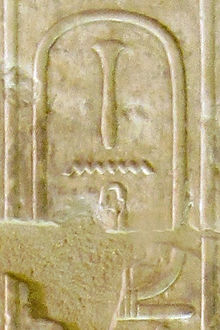Wadjenes
| Wadjenes | |
|---|---|
| Wadjlas, Ougotlas, Outlas, Tlas | |

Cartouche name of Wadjenes in the Abydos King List (cartouche no. 12)
|
|
| Pharaoh | |
| Reign | length of reign unknown (2nd Dynasty; around 2740 B.C.) |
| Predecessor | Banetjer |
| Successor | Senedj |
Wadjenes (ancient Eyptian Wadj-nes, which means "fresh of tongue"), also known as Wadjlas, Ougotlas and Tlas, is the name of an early Egyptian king who may have ruled during the 2nd dynasty. Since the name form "Wadjenes" is not contemporarily attested as the name of a king, but frequently appears in Ramesside kinglists, Egyptologists to this day are trying to connect Wadjenes with contemporary Horus-kings.
The king's name "Wadjenes" is attested only in the Ramesside kinglists, where he is always presented as the immediate successor of king Nynetjer and as the predecessor of king Senedj. The same goes for the Royal Canon of Turin, where the entry for his name is damaged so only the years of rulership are preserved.
Whilst all kinglists match each other regarding the chronological position of Wadjenes, Egyptologists are uncertain as to the origin of the name "Wadjenes". Egyptologists and historians such as Winfried Barta, Bernhard Grdseloff and Iorwerth Eiddon Stephen Edwards believe that the papyrus haulm, the first symbol in Wadjenes's name, is an misinterpretation of the hieroglyphic sign of a flower called Weneg (also read as Uneg), which is rarely used in Egyptian writing. A king Weneg (also written as "Weneg-Nebti") is also contemporarily identified by black ink-inscriptions on alabaster-shards and as incised writings on schist vessels originating from the underground galleries beneath the step pyramid of king Djoser at Sakkara. It is possible that ramesside scribes interchanged the Weneg flower with the papyrus haulm, since both signs are very similar to each other in hieratic script.
...
Wikipedia
